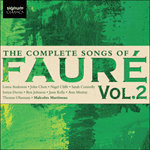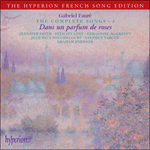
Welcome to Hyperion Records, a British classical label devoted to presenting high-quality recordings of music of all styles and from all periods from the twelfth century to the twenty-first.
Hyperion offers both CDs, and downloads in a number of formats. The site is also available in several languages.
Please use the dropdown buttons to set your preferred options, or use the checkbox to accept the defaults.

This substantial work by Charles Van Lerberghe appeared in 1904 and is dedicated to Émile Verhaeren. Fauré’s friend Alfred Mockel introduced the composer to this poetry which attracted him immediately. The work contains ninety-six poems and is divided into five sections: Fauré passes over the Prélude and begins his cycle with the first poem of Premières paroles (3), followed by 8, 7, 12, 16, 22 from the same section. (It is clear that the wonder of the Creation and the garden of Eden interest Fauré far more than Eve’s fall from grace.) There is a single poem from La tentation (39) before a return to Premières paroles (29). The eighteen poems of La faute are ignored entirely. The cycle ends with poems 86 and 94 (the third to last poem) from Crépuscule which the composer also adopts as the title of the penultimate song; thus Fauré’s cycle follows Van Lerberghe’s chronology only to a generalized extent; it skims the surface of the poet’s portrait of Eve while deepening it with matchless music. The opening lines of the poems are their only titles, thus Paradis, Prima verba and Eau vivante are Fauré’s own.
In motivic terms La chanson d’Ève is a less complex composition than La bonne chanson with its five recurring themes. In other ways, despite the fact that the music seems far less dense on the page, the later cycle is far more ambitious. Fauré, not yet as old as Haydn when he wrote Die Schöpfung, undertakes nothing less than a ‘Creation’ of his own. Eve is a cosmic figure, the grandest protagonist in any of the female song cycles; and we hear the voice of God Himself, a unique event in the song repertoire. So absorbing is this picture that the absence of Adam (from Fauré’s scenario at least) seems hardly worthy of comment.
from notes by Graham Johnson © 2005
Fauré fut d’emblé séduit par cette poésie de Charles Van Lerberghe, à laquelle son ami Alfred Mockel l’initia. Substantielle, cette oeuvre de 1904 dédiée à Émile Verhaeren comprend quatre-vingt-seize poèmes répartis en cinq sections: Fauré saute le Prélude et commence son cycle par le premier poème des Premières paroles (3). Viennent ensuite les poèmes nos 8, 7, 12, 16 et 22 de la même section. (Il est évident que les merveilles de la Création et le jardin d’Éden intéressent bien plus Fauré qu’Ève perdant la grâce.) Un seul poème est extrait de La tentation (39), qui précède un retour aux Premières paroles (29). Les dix-huit poèmes de La faute sont laissés de côté et le cycle s’achève sur les nos 86 et 94 (l’antépénultième) du Crépuscule—mot dont Fauré fait aussi le titre de son avant-dernière mélodie; le cycle suit donc la chronologie de Van Lerberghe, du moins dans les grandes lignes: il effleure le portrait d’Ève tel que le brosse le poète, mais il l’approfondit aussi avec une musique sans égale. Les poèmes n’ayant pour titre que leurs seuls premiers vers, Paradis, Prima verba et Eau vivante sont des inventions de Fauré.
Sur le plan motivique, La chanson d’Ève est moins complexe que La bonne chanson, avec ses cinq thèmes récurrents. Autrement, et bien que la musique donne l’impression visuelle d’être bien moins dense, le cycle le plus tardif est de loin le plus ambiteux. Fauré, qui n’avait pas encore l’âge du Haydn de Die Schöpfung, entreprend rien de moins que sa «Création» à lui. Ève est une figure cosmique, la plus grandiose portagoniste de tous les cycles féminins; et l’on entend la voix de Dieu Lui-même—un événement unique dans le répertoire de la mélodie. Ce tableau est tellement captivant que l’absence d’Adam (chez Fauré du moins) semble à peine valoir d’être commentée.
extrait des notes rédigées par Graham Johnson © 2005
Français: Hypérion
 Fauré: The Complete Songs, Vol. 2 Fauré: The Complete Songs, Vol. 2Malcolm Martineau brings together some of the UK’s finest singers for the second release in his series of the complete songs of Gabriel Fauré.» More |
 Fauré: The Complete Songs, Vol. 4 - Dans un parfum de roses Fauré: The Complete Songs, Vol. 4 - Dans un parfum de roses‘There are songs of a fragrance, ambiguity and vision unique to Fauré and all the singers involved in this glorious project, while not always in their ... ‘This completes Hyperion's recording of all Fauré's songs master-minded by Graham Johnson with a quintet of specialist singers: Jennifer Smith, Felici ...» More |

